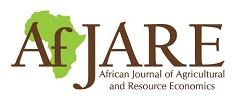All Articles
- All
- Special Issue
- Volume 13-1
- Volume 13-2
- Volume 13-3
- Volume 14-1
- Volume 14-2
- Volume 14-3
- Volume 14-4
- Volume 15-1 (March 2020)
- Volume 15-2 (June 2020)
- Volume 15-3 (September 2020)
- Volume 15-4 (December 2020)
- Volume 16-1 (March 2021)
- Volume 16-2 (June 2021)
- Volume 16-3 (September 2021)
- Volume 16-4 (December 2021)
- Volume 17-1 (March 2022)
- Volume 17-2 (June 2022)
- Volume 17-3 (September 2022)
- Volume 17-4 (December 2022)
- Volume 18-1
- Volume 18-2 (June 2023)
- Volume 18-3
- Volume 19-1
- Volume 19-2
- Volume 19-3
- Volume 19-4
- Volume 20-1
- Volume 20-2
- Volume 20-3
- Volume 20-4
- Volume 8-1
- Volume 8-3
Empirical studies on the effects of governance structures on incentives have still received little attention in the wheat value chain research of developing countries. The purpose of this paper is to investigate the effects of governance structures on actors’ incentives in different functional nodes of the wheat value chain.
This study examined the effect of collective marketing on mango income for 226 smallholder farmers in Mwala sub-county. The study employed an endogenous switching regression model to account for selection bias from observed and unobserved farmer attributes.
A new high-yielding upland rice variety known as New Rice for Africa (NERICA) has been recognised widely as a promising technology for addressing the food shortage and poverty problems in sub-Saharan Africa.
This study characterises the nature of the vegetable production shortfall throughout Ghana for remedial action to be taken. By applying the meta-stochastic frontier analysis to a sample of okra, pepper and tomato farmers, the results show that the ranking of production inputs in production is in the order land, hired labour, fertiliser, pesticide and family labour.
Uganda’s climate is changing in terms of rising temperatures and altered precipitation patterns, leading to extreme meteorological conditions such as prolonged drought, floods and landslides. Yet the majority (68%) of Ugandans rely largely on rain-fed agriculture, which is affected by climate variability.
Bien que l’économie africaine en général et celle de l’Afrique de l’ouest en particulier demeure fortement dépendante du secteur agricole, ce dernier s’avère être le moins productif parmi les trois grands secteurs considérés de l’économie, notamment le secteur agricole, industriel et des services.
The impact of women’s empowerment in agriculture on women\s health, indicated by their body mass index (BMI), is examined using an instrumental variable estimation approach on a sample of 4 267 women.
This study examines how food prices and related seasonality factors affect the dietary choices of low-income farm households in rural Tanzania. The Kishapu and Mvomero districts were selected based on contrasting rainfall patterns, farming practices and economic activities.
One of the debates around sustainability and the scaling up of micro-financial services is the commercialisation of micro-finance institutions (MFIs). This paper examines the contribution of the commercialisation of MFIs to ensuring the sustainability of MFIs and in scaling up their commitment to serve their primary target groups: poor and marginalised people.
This study analysed the long- and short-run effect of economic policy uncertainty on agricultural growth in Nigeria. Annual data was collected from secondary sources and analysed using the autoregressive distributed lag (ARDL) model and the associated bounds test.
Insect pollination improves the yield of most crop species and contributes to one-third of global crop production. The importance of this ecosystem service in improving agricultural production has largely been overlooked, however, in favour of practices that improve soil conditions such as fertiliser use and supplementary irrigation.
The hazards and impacts of climate change are exacerbating. They threaten crop productivity, farmers’ resilience and the mitigation of greenhouse gas (GHG) emissions. Understanding climate-smart agriculture (CSA) and applying it is crucial.
This article investigated the role of cattle attributes in buyers’ choices and hedonic pricing in Benin. Cross-sectional data were collected on 347 market cattle transactions using the revealed preference method.
This study uses primary data from smallholder sugarcane farmers in Kenya to investigate how women’s empowerment affects household poverty. Instrumental-variable tobit (IV tobit) was used to determine the causality between women’s empowerment and household poverty.
The study provides evidence for how risk preferences determine fishing location choices by artisanal fishers on the south-west coast of the island of Mauritius. Risk preference is modelled using a random linear utility framework defined over mean-standard deviation space.
Climate change presents one of the most pressing challenges of the present time, with far-reaching implications for global economies and human socioeconomic well-being.
Does commercialisation drive technical efficiency improvements in Ethiopian subsistence agriculture?
The conditions in which increased market participation leads to improved technical efficiency are still not adequately understood. This study therefore investigated farmers’ market participation rates and their predicted technical efficiency scores by performing a two-stage least squares (2SLS) regression analysis using household-level data obtained from the 2009 Ethiopian rural household survey.
This study uses an online laboratory experiment and a post-experimental survey to test whether the Mastercard Foundation (MCF) scholarship programme causally influences the creation of cognitive social capital among University of Pretoria recipients.
Livestock, particularly cattle, are an integral part of livelihoods in rural sub-Saharan Africa. However, diseases such as African animal trypanosomosis (AAT) have limited the potential of this important sector in the rural household economy.
In sub-Saharan Africa, identifying estimates of consumers’ preferences and willingness to pay (WTP) for safe food continues to receive attention in the literature. Using experimental data from Nigeria, we examined the source of heterogeneities in preference and WTP for organically produced food.
